Abstract
Objective
To investigate how bracket slot size affects the direction of maxillary anterior tooth movement when en-masse retraction is performed in sliding mechanics using an induction-heating typodont simulation system.
Methods
An induction-heating typodont simulation system was designed based on the Calorific Machine system. The typodont included metal anterior and resin posterior teeth embedded in a sticky wax arch. Three bracket slot groups (0.018, 0.020, and 0.022 inch [in]) were tested. A retraction force of 250 g was applied in the posterior-superior direction.
Results
In the anteroposterior direction, the cusp tip of the canine in the 0.020-in slot group moved more distally than in the 0.018-in slot group. In the vertical direction, all six anterior teeth were intruded in the 0.018-in slot group and extruded in the 0.020- and 0.022-in slot groups. The lateral incisor was significantly extruded in the 0.020- and 0.022-in slot groups. Significant differences in the crown linguoversion were found between the 0.018- and 0.020-in slot groups and 0.018- and 0.022-in slot groups for the central incisor and between the 0.018- and 0.022-in slot groups and 0.020- and 0.022-in slot groups for the canine. In the 0.018-in slot group, all anterior teeth showed crown mesial angulation. Significant differences were found between the 0.018- and 0.022-in slot groups for the lateral incisor and between the 0.018- and 0.020-in slot groups and 0.018- and 0.022-in slot groups for the canine.
With the recent increase in use of straight wire appliances, sliding mechanics have been widely used for extraction space closure. Moreover, the retraction of the six maxillary anterior teeth without anchorage loss is possible because of the development of skeletal anchorage. 123
En-masse retraction using microimplants and sliding mechanics shortens the treatment time and is advantageous for adjusting the inclination of maxillary anterior teeth.4
Optimizing the placement height of the microimplant, the height of the anterior hook, and the amount of torquing curve is necessary for controlling the inclination of maxillary anterior teeth.5678 In practice, however, a long observation period is required to determine movement patterns during the retraction of maxillary anterior teeth, and accurate comparative studies are difficult due to the convenience of treatment and diversity of patients. Several studies have examined the patterns of tooth movement under specific force systems, and measurements made using photo-elasticity,91011 orthodontic force testers,12 laser holography,13 the finite element method,14 and the simulation method using a Calorific Machine have been used.15161718 These methods, however, are different from situations encountered in the clinic, and the ability to predict actual tooth movement is quite limited.
With the application of existing typodonts, the use of the Calorific Machine has allowed researchers to examine dynamic tooth movement; however, this method is associated with several disadvantages, including interference of the wire connected to the crown part for measurement of temperature with free tooth movement and the heaviness of the rolled wire used for heating.
Therefore, in this study, we designed a new typodont simulation device19 in order to analyze the effects of bracket slot size on movement patterns of the maxillary anterior teeth during en-masse retraction using microimplant anchorage and sliding mechanics for tooth extraction.
Three brackets of different slot sizes (0.018, 0.020, and 0.022 inch [in]) were attached on the six maxillary anterior teeth of a new typodont in which the first premolar was extracted. The same retraction wire (0.016 × 0.022 in, stainless steel) and posterior-superior retraction force were applied, and the six metal maxillary anterior teeth were heated in the absence of wires to allow tooth movement (Figure 1). Images were taken at the same position to measure the movement and change in axis for each tooth.
The metal teeth were maintained at 60–65℃, which is the softening temperature for sticky wax, in order to allow tooth movement (only the wax around roots was minimally softened). The heat supply was stopped immediately after retraction was finished, and the amount of tooth movement was measured. The experiments were repeated five times for each slot group.
Brackets with different slot sizes (0.018, 0.020, and 0.022 in) were made by Dentos Inc. (Daegu, Korea) specifically for this study. The brackets included torque values as follows: central incisor, 12°; lateral incisor, 8°; and canine, −2°. Because the shapes of the brackets were identical (with the exception of slot size), the three types of brackets could be bonded at the same location using transfer trays (Figure 2). For the second premolar, 0.022-in slot brackets (Victory; 3M Unitek, Monrovia, CA, USA) were used. For the first and second molars, tubes (Victory) were used.
A 0.016 × 0.022 in stainless steel wire (Truform I; G&H Orthodontics, Franklin, IN, USA) was used as the main arch wire, and a crimpable hook was fixed between the lateral incisor and canine. The central incisor, lateral incisor, and canine were ligated with a 0.009-in stainless steel ligature wire, and the second premolar was not ligated in order to eliminate the frictional differences caused by ligation. This bracket and wire combination was suggested by Park,20 who described sliding mechanics using microimplants.
En-masse retraction was conducted using an anterior hook (3 mm height from the wire) and anchorage bar between the second premolar and first molar (8 mm height from the wire) to observe lingual tipping of the maxillary anterior teeth. Based on previous research, controlled tipping movement of maxillary anterior teeth was expected.21
In the study by Park,20 lingual tipping of the maxillary anterior teeth was prevented by applying retraction in the posterior-superior direction, and extrusion of the maxillary anterior teeth was prevented by applying a torquing curve on the wire. However, the curve was not used in this experiment.
An 8-mm heavy force Niti coil spring (NT25-8H, Dentos Inc.) was used to provide 250 g force per side, which was determined by the appropriate retraction achieved throughout this experiment. The wire was retracted 2 mm in the posterior direction.
A principle of induction heater was applied to generate heat by creating eddy currents on the metal inside the magnetic field by changing the direction of the magnetic field frequently in the solenoid coil. Using this, only the wax was melted around the metal root, and the metal tooth moved in proportion to the locally applied force. The temperature of the six metal maxillary anterior teeth was kept between 63℃ and 65℃, controlled by a wireless infrared temperature measuring instrument. The system comprised the main instrument that converted the magnetic field with high frequency and a coil box that heated the typodont (Figure 3A and 3B).
In order to heat the six maxillary anterior teeth with the magnetic field, aluminum teeth were produced with a computer-aided design and computer-aided manufacturing (CAD-CAM) system. Aluminum is softer and lighter weight than ferrous metal; therefore, it is easy to handle, and the influence of gravity may be reduced. Moreover, it is not strongly magnetic and does not heat up to high temperatures by induction heating (Figure 3C).
Sticky wax is a mixture of wax and resin that dissolves at temperatures of 60–65℃. If force is applied during hardening, sticky wax will fracture rather than become deformed. Thus, tooth movement is only possible near the heated tooth at temperatures close to the softening temperature as the resistance becomes weaker. Transformation of the whole alveolar bone model can be minimized.
Model teeth were aligned ideally with extraction of first premolars. A wax typodont was then created to include model teeth by pouring sticky wax on a silicon mold the same size as the silicon typodont (Figure 4). Next, 0.020-in slot brackets were ligated with a full size stainless steel wire (Truform I). The brackets were then attached on the maxillary model teeth. A transfer tray was created using pattern resin in order to reproduce the same bracket location.
Bars with a 1.5-mm unit scale were used to conduct experiments at diverse heights for absolute anchorage; these were used as substitutes for microimplants (Figure 5).
The distance and angle were measured by taking images at the same position using a digital camera (DSC-W350 Cyber-Shot; Sony, Tokyo, Japan) and Adobe Photoshop 6.0 software (Adobe Systems, San Jose, CA, USA). To facilitate imaging at identical locations, the clamp that held the typodont and the tripod that held the camera were fixed. The subject was photographed from a longer distance, with the image in the center of the camera, in order to reduce distortion of the image. The position of teeth was measured from a fixed construct (e.g., the resin frame of the typodont). Front and side images of each tooth were obtained, showing inclination and angulation as well as the occlusal surface, and sagittal images were also taken for linear measurement.
The amount of maxillary anterior tooth movement at the incisal edge on occlusal surface images was measured by marking the center of each incisal edge. The forward and backward movements of the crown on the occlusal surface photo were measured according to a marking on the center of each maxillary anterior tooth incisal edge (Figure 6A). Vertical movement was measured in sagittal images (Figure 6B). A positive sign indicates anterior movement and extrusion.
A 0.019 × 0.025-in stainless steel wire suitable for the crown was attached on the resin cap in order to measure the axial angle. Front and side images of each tooth were taken, and the angles were measured (Figure 7). A positive sign indicates buccal crown inclination.
The average of left and right measurements was calculated. For reliability tests, three samples were extracted randomly for each bracket, and the same investigator remeasured the values at 2-week intervals. The measurements were performed at least twice for each case and were analyzed by paired t-test. Dahlberg's formula (ME2 = Σd2 / 2n) was used in the random error analysis.
One-way analysis of variance (ANOVA) was conducted to test the changes in tooth movement according to the size of each bracket slot, and the Tukey honest significant difference (HSD) test, a multiple comparison method, was conducted as a post-hoc test. The statistically significant level was set at 95%, and SPSS Statistics version 17.0 (SPSS Inc., Chicago, IL, USA) was used.
There were no statistically significant differences in intra-examiner error, as determined by paired t-tests (p > 0.05). Dahlberg's formula was used to test random error; the average error level was 0.15 mm (error range, 0.09–0.25 mm) in linear measurements, and average error level was 0.27° (error range, 0.04–2.20°) in angular measurements.
Although an identical force is applied, the movement at the incisal edges of the maxillary anterior teeth may be different due to the axial change. For the canine, we observed a statistically significant difference in movement between the 0.018- and 0.020-in slot groups. The movement of the canine cusp tip increased in the 0.020-in slot group compared with the 0.018-in slot group because of distal tipping (Table 1, Figure 8).
All maxillary anterior teeth were displaced intrusively in the 0.018-in slot group but exhibited extrusion displacement in the 0.020- and 0.022-in slot groups. Statistically significant differences between the 0.018- and 0.020-in slot groups and the 0.018- and 0.022-in slot groups were also observed for the lateral incisor (Table 2, Figure 9).
Statistically significant differences in inclination were observed for the central incisor and canine. As the bracket slot size became larger, crown lingual tipping increased significantly between the 0.018- and 0.020-in slot groups and the 0.018- and 0.022-in slot groups for the central incisor and between the 0.018- and 0.022-in slot groups and the 0.020- and 0.022-in slot groups for the canine (Tables 1 and 3, Figures 8 and 10).
All maxillary anterior teeth in the 0.018-in slot group showed mesial crown tipping. Statistically significant differences in the angulation of the lateral incisor were observed between the 0.018- and 0.022-in slot groups. Significant differences were also observed between the 0.018- and 0.020-in slot groups and the 0.018- and 0.022-in slot groups for the canine (Tables 1 and 2, Figures 8 and 9).
In order to improve the existing Calorific Machine method, we developed a device that moved only the target teeth but prevented changes to other surrounding structures, including wax alveolar bone. Our design included an induction-heating device that provided heat to metal teeth wirelessly, maintaining a temperature of 60–65℃ and allowing the softening of sticky wax. This novel typodont device allowed efficient retraction of six maxillary anterior teeth.
Among methods for preventing lingual tipping of anterior teeth, we chose not to use the torquing curve because this method is difficult to reproduce accurately. Because of this, the effects of different slot sizes were clearer. Additionally, the second premolar was not ligated. In contrast to situations encountered in the clinical setting, posterior teeth were fixed. We believe that ligation is not necessary and may be disadvantageous for reducing frictional differences.
In this study, all teeth were intruded in the 0.018-in slot group only, while all teeth were extruded in the 0.020- and 0.022-in slot groups (Figure 11). There are two possible explanations for this result. First, all maxillary anterior teeth would be intruded if heated for a sufficient amount of time because retraction was performed in the posterior-superior direction. However, we immediately removed the heat supply when the arch wire moved 2 mm in the posterior direction. Interestingly, the retraction time in the 0.018-in slot group was longer than that for the other groups. This may have been due to root movement in the 0.018-in slot group, which had the least amount of play. Second, this observation may have resulted from increased distal tipping of the canine due to the increased play between the bracket slot and wire; this would provide a force on the wire in front of the canine, resulting in downward bending (Figure 11D). These explanations may support maintaining of the maxillary anterior tooth axis by preventing distal tipping of the canine with the torquing curve, even if using a thin wire, as described by Song7 and Park.20
The second order bend became a third order bend in the canine. Therefore, we expected that the difference in inclination would be greater than the difference in angulation for the central incisor and that the difference in angulation would be greater than the difference in inclination for the canine. While no statistically significant differences were observed, the results were as expected. Interestingly, an intermediate response was observed in the lateral incisor.
Unfortunately, it was impossible to implement symmetry dentition with the device used in this experiment. We expected that there would not be a difference in the trends, but that the measurements may differ from left to right; therefore, the average of the left and right measurements was used. However, the trends of left and right teeth were discrepant, and the standard deviations of the measurements were increased, reducing the clarity of the statistical results. Differences according to bracket slot size may be more clearly understood if the shapes of the left and right teeth were made symmetrical, reducing the number of variables.
With the new typodont device developed herein, the six maxillary anterior teeth were retracted 2 mm with a 0.016 × 0.022-in stainless steel wire set at a 3 mm anterior hook height, from the 8 mm height of the posterior microimplant anchorage with 250 g force. The posterior movement of the cusp tip increased as the canine was tipped in the 0.020-in slot group compared with the 0.018-in slot group. Moreover, in the 0.018-in slot group, all maxillary anterior teeth were intruded; in contrast, all maxillary teeth were extruded in the 0.020- and 0.022-in slot groups. More extrusion occurred as the bracket slot size was enlarged. The crown lingual inclination also increased as the bracket slot size increased. All maxillary anterior teeth showed crown mesial angulation in the 0.018-in slot group compared with the other groups.
Because there were few significant differences between the 0.020- and 0.022-in slot groups, we suggest that the use of 0.018-in slot brackets may be effective for controlling the sliding mechanics of the maxillary anterior tooth axis when the torquing curve is not applied using a 0.016 × 0.022-in wire.
References
1. Park HS, Bae SM, Kyung HM, Sung JH. Micro-implant anchorage for treatment of skeletal Class I bialveolar protrusion. J Clin Orthod. 2001; 35:417–422. PMID: 11494827.
2. Jee JH, Ahn HW, Seo KW, Kim SH, Kook YA, Chung KR, et al. En-masse retraction with a preformed nickel-titanium and stainless steel archwire assembly and temporary skeletal anchorage devices without posterior bonding. Korean J Orthod. 2014; 44:236–245. PMID: 25309863.
3. Lee J, Miyazawa K, Tabuchi M, Sato T, Kawaguchi M, Goto S. Effectiveness of en-masse retraction using midpalatal miniscrews and a modified transpalatal arch: Treatment duration and dentoskeletal changes. Korean J Orthod. 2014; 44:88–95. PMID: 24696825.
4. Park HS, Kwon TG. Sliding mechanics with microscrew implant anchorage. Angle Orthod. 2004; 74:703–710. PMID: 15529508.
5. Kim YC. Finite element analysis of the effect of wire thickness on tooth movement in sliding mechanics. MSD thesis. Daegu, Korea: Kyungpook National University;2003.
6. Ji MJ. The effect of amount of torquing curve and thickness of archwire on the angulation of the teeth in six anterior teeth retraction. PhD thesis. Daegu, Korea: Kyungpook National University;2005.
7. Song HS. Three-dimensional finite element analysis of tooth axis of maxillary anterior teeth during retraction with microimplant. MSD thesis. Daegu, Korea: Kyungpook National University;2006.
8. Seo KW, Kwon SY, Kim KA, Park KH, Kim SH, Ahn HW, et al. Displacement pattern of the anterior segment using antero-posterior lingual retractor combined with a palatal plate. Korean J Orthod. 2015; 45:289–298. PMID: 26629475.

9. Lee HC, Chun YS. A photoelastic study on the initial stress distribution of 3 types TMA multi-vertical loop arch wire. Korean J Orthod. 1995; 25:73–85.
10. Chaconas SJ, Caupto AA, Miyashita K. Force distribution comparisons of various retraction archwires. Angle Orthod. 1989; 59:25–30. PMID: 2923318.
11. Caputo AA, Chaconas SJ, Hayashi RK. Photoelastic visualization of orthodontic forces during canine retraction. Am J Orthod. 1974; 65:250–259. PMID: 4521359.

12. Chen J, Isikbay SC, Brizendine EJ. Quantification of three-dimensional orthodontic force systems of T-loop archwires. Angle Orthod. 2010; 80:566–570. PMID: 20482364.

13. Kumar YM, Ravindran NS, Balasubramaniam MR. Holographic analysis of the initial canine displacement produced by four different retraction springs. Angle Orthod. 2009; 79:368–372. PMID: 19216610.

14. Moss ML, Skalak R, Patel H, Sen K, Moss-Salentijn L, Shinozuka M, et al. Finite element method modeling of craniofacial growth. Am J Orthod. 1985; 87:453–472. PMID: 3859222.

15. Chun YS, Row J, Jung SH, Kim HJ. A study on the effect of the magnitude of the gable bends on the tooth movement pattern during en-masse space closure in the maxillary dentition. Korean J Orthod. 2004; 34:33–45.
16. Jeon HJ, Park SH, Jung SH, Chun YS. Three dimensional analysis of tooth movement using different sizes of NiTi wire on NiTi scissors-bite corrector. Korean J Orthod. 2009; 39:43–53.

17. Rhee JN, Chun YS, Row J. A comparison between friction and frictionless mechanics with a new typodont simulation system. Am J Orthod Dentofacial Orthop. 2001; 119:292–299. PMID: 11244423.

18. Kim SJ, Chun YS, Jung SH, Park SH. Three dimensional analysis of tooth movement using different types of maxillary molar distalization appliances. Korean J Orthod. 2008; 38:376–387.

19. Kyung HM, Kim JY, Kyung IK. Heat Induction Typodont System® (HITS) for simulating orthodontic tooth movement. Clin J Korean Assoc Orthod. 2013; 3:177–178.
20. Park HS. Orthodontic treatment using micro. Seoul: Daehan Nare Publishing;2006.
21. Sia S, Shibazaki T, Koga Y, Yoshida N. Experimental determination of optimal force system required for control of anterior tooth movement in sliding mechanics. Am J Orthod Dentofacial Orthop. 2009; 135:36–41. PMID: 19121498.

Figure 1
Schematic diagram of the new induction-heating typodont simulation system devised in this study.
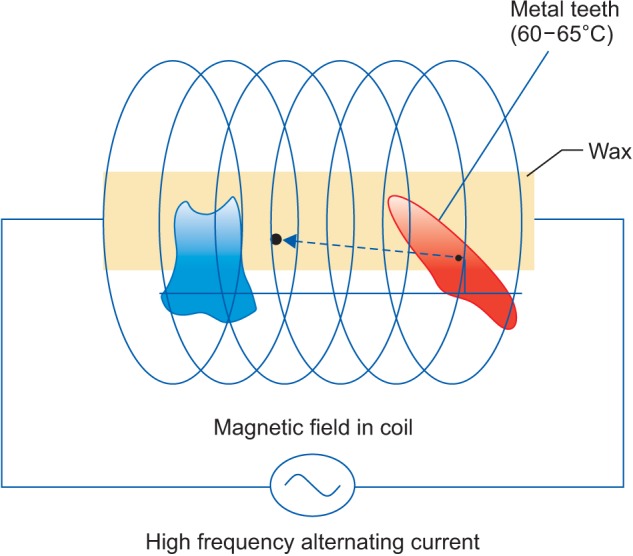
Figure 2
Three brackets, each with a different slot size (0.018, 0.020, and 0.022-inch from left to right). Except for the different in slot size, all other dimensions were the same.
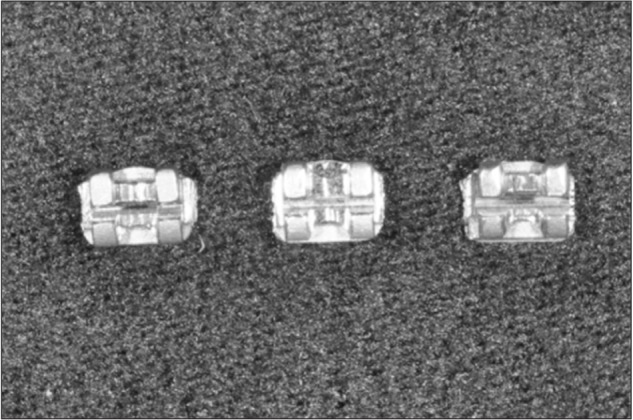
Figure 3
The new typodont simulation system. A, The overall set-up; B, the coil box; C, six aluminum anterior teeth and six resin posterior teeth.
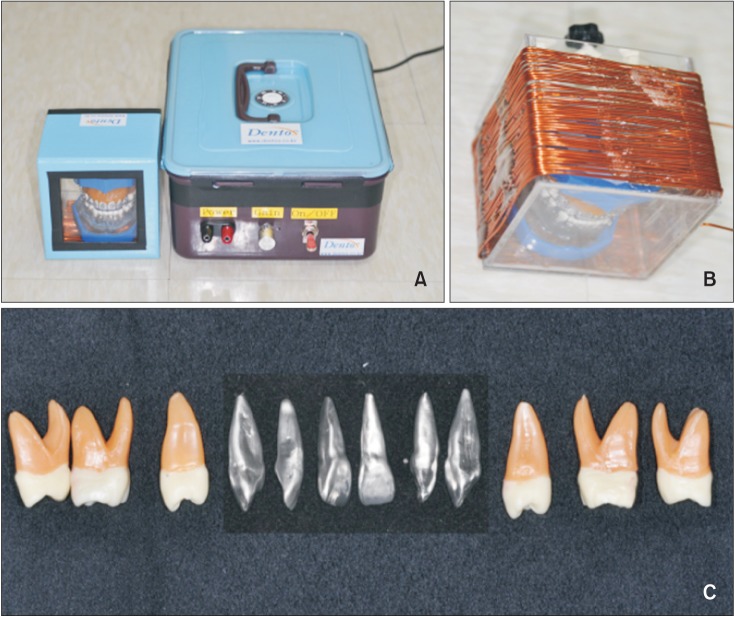
Figure 5
Set-up of the new typodont model. A first premolar extraction case model consisting of sticky wax alveolar bone, aluminum anterior and resin posterior teeth, anterior hook, posterior anchorage bar, and Niti coil spring for retraction.
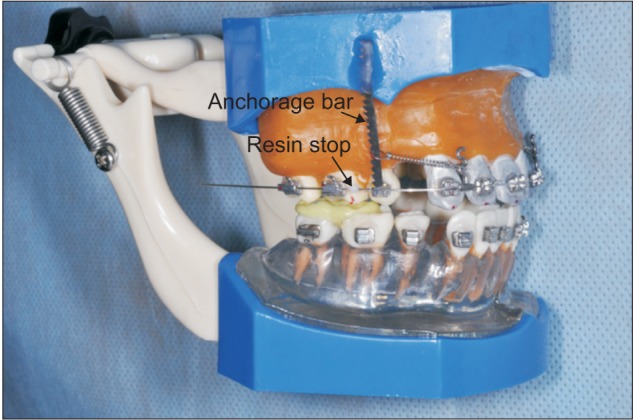
Figure 6
Linear measurements. A, Occlusal view; B, sagittal view (+: anterior and extrusion directions).
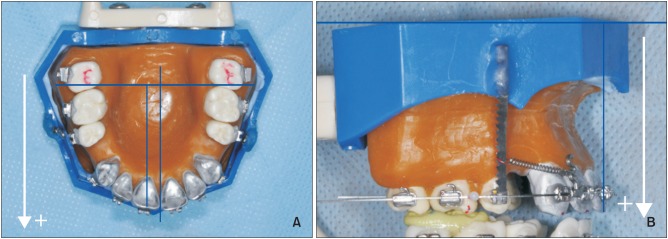
Figure 11
Movement of anterior teeth. A, 0.018-inch (in) slot bracket; B, 0.020-in slot bracket; C and D, 0.022-in slot bracket.
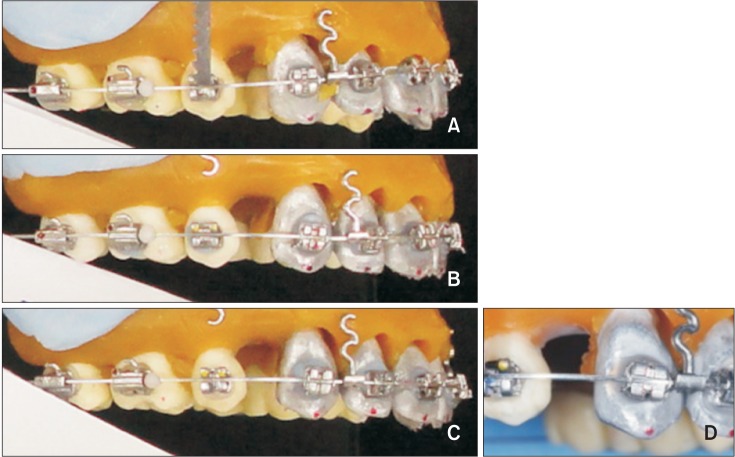




 PDF
PDF ePub
ePub Citation
Citation Print
Print


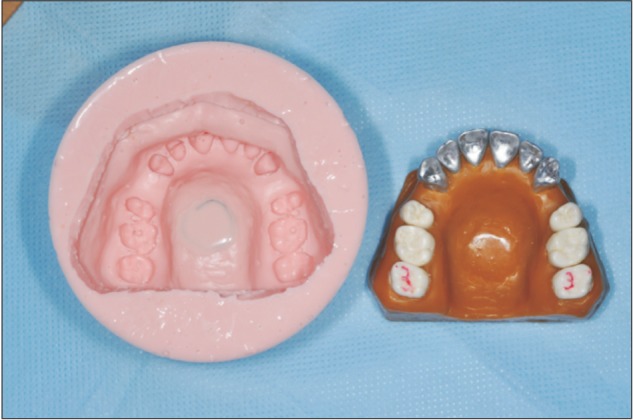
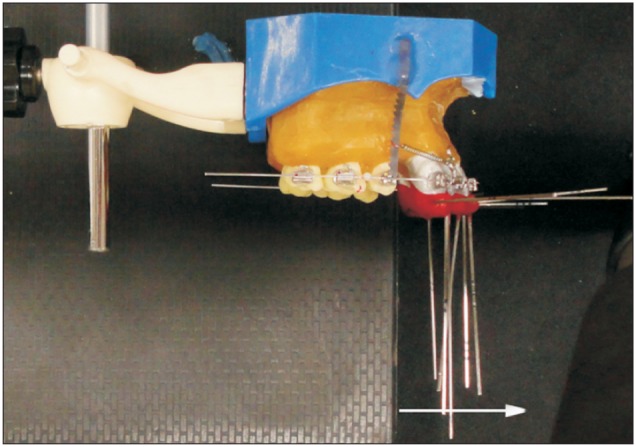
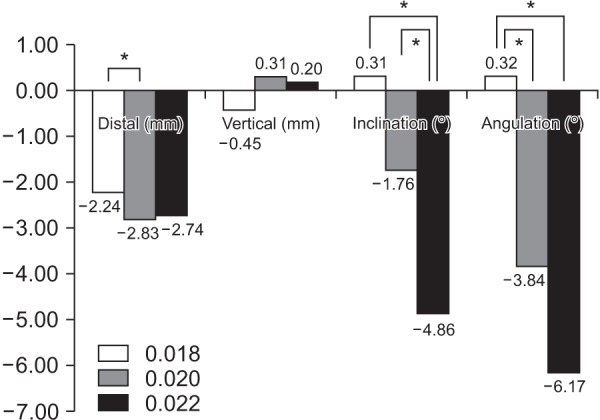
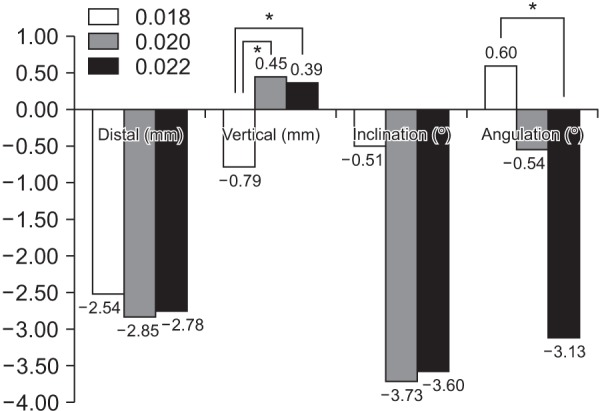
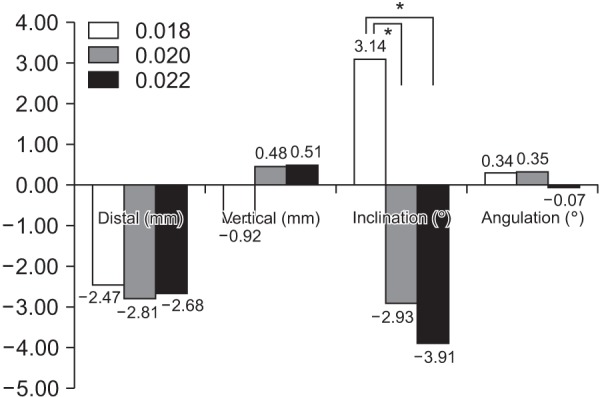



 XML Download
XML Download